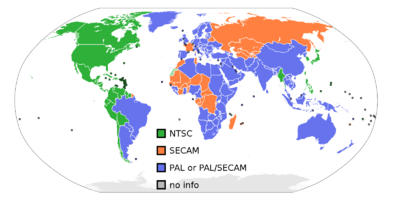NTSC: Difference between revisions
Destructodon (talk | contribs) m (minor addition) |
No edit summary |
||
| Line 1: | Line 1: | ||
{{ArticleIcons|series=y}} | {{ArticleIcons|series=y}} | ||
[[File:PAL-NTSC-SECAM.png|thumb|400px|Regions of the world which used the different encoding systems]] | {{merge|PAL|Literally the same article with some reversed wording; carbon copy layout.}}[[File:PAL-NTSC-SECAM.png|thumb|400px|Regions of the world which used the different encoding systems]] | ||
{{art-wikipedia}} | {{art-wikipedia}} | ||
Within the video game community, '''NTSC''' is a term used to refer to the region of North America and small parts of South America and Asia. The term comes from the analog television encoding system '''National Television System Committee''', the primary method of encoding analog TV for North America, South America, and Japan. | Within the video game community, '''NTSC''' is a term used to refer to the region of North America and small parts of South America and Asia. The term comes from the analog television encoding system '''National Television System Committee''', the primary method of encoding analog TV for North America, South America, and Japan. | ||
Revision as of 23:54, March 8, 2016
Within the video game community, NTSC is a term used to refer to the region of North America and small parts of South America and Asia. The term comes from the analog television encoding system National Television System Committee, the primary method of encoding analog TV for North America, South America, and Japan.
NTSC is most commonly used as shorthand for "the North American version of a game". Historically, North America is usually the second region for games made in Japan to be released, as only one translation is necessary (English) for arguably the most important overseas market. As a result, NTSC releases are often the second version of the game, with major bugs fixed and possibly minor changes added.
Summary of NTSC releases of the Super Smash Bros. series
Super Smash Bros.
The original Super Smash Bros.'s NTSC release contains a great deal of changes from its Japanese counterpart. Several changes were made to almost all characters, most notably Link and Ness, both of whom were theoretically nerfed down over a tier's worth of tier list positioning.
Super Smash Bros. Melee
Aside from translations, there is effectively no difference at all between the Japanese and NTSC versions of Melee - both versions of the game even include each others' language available for selection. Both regions received the same revisions between versions 1.0, 1.1, and 1.2.
Super Smash Bros. Brawl
In order for cross-region online play to be possible, the only differences between versions of Brawl are purely aesthetic.
Super Smash Bros 4.
The two editions of Super Smash Bros 4 have only aesthetic changes, for similar reasons as Brawl.


